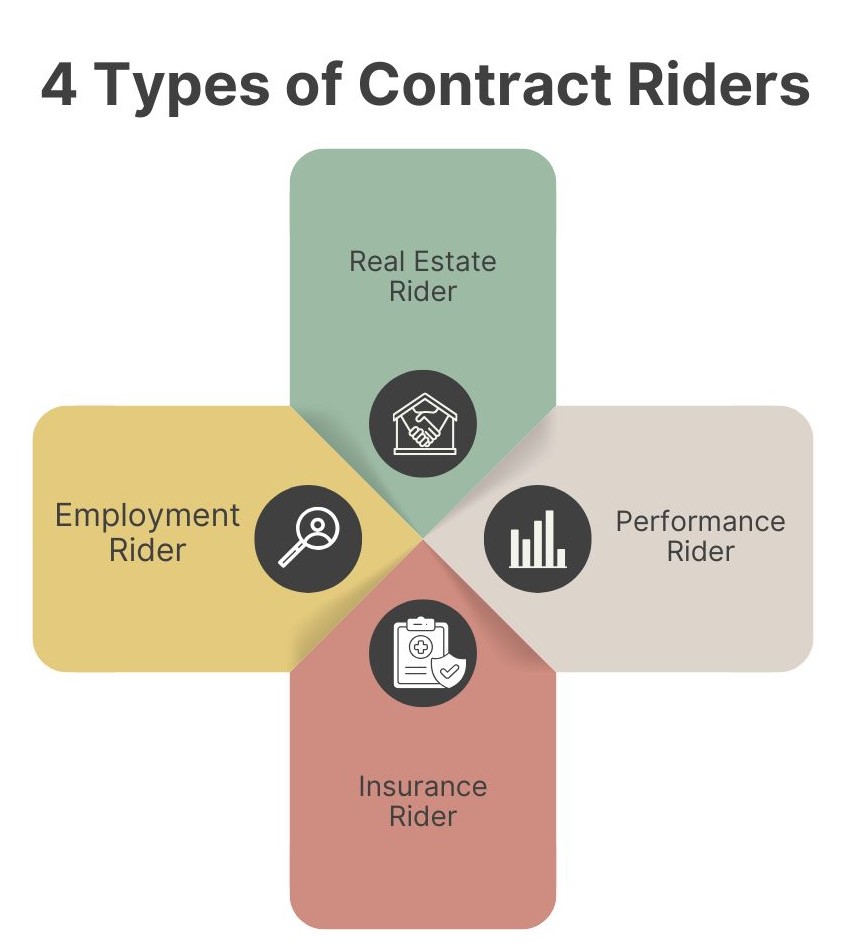In the world of business, contracts are the foundation upon which agreements are built. But, what happens when you need to customize the agreement to meet specific needs? That’s where a contract rider comes into play. A contract rider is a crucial element that can help fine-tune an existing contract without requiring a complete rewrite. Whether you’re involved in entertainment, real estate, or any other industry, understanding contract riders is essential to protecting your interests and ensuring your needs are met. In this article, we will examine the definition of a contract rider, its numerous varieties, potential applications, and the process of drafting a robust rider that satisfies your needs.
What Is a Contract Rider?
At its core, a contract rider is an amendment or addendum to an existing contract. It’s designed to modify or add specific terms and conditions that aren’t originally outlined in the contract itself. A contract rider is typically used when there are special requirements or unique circumstances that need to be accounted for without altering the entire agreement.
For example, in the entertainment industry, performers often have contract riders detailing specific requirements for accommodations, stage setup, or hospitality. These riders ensure that both parties are clear on the expectations and that there’s no room for misunderstanding.
One of the biggest advantages of using a contract rider is its flexibility. It allows parties to customize a contract to suit their individual needs without having to negotiate an entirely new agreement. Instead, the contract rider supplements or modifies existing terms.
Why Do You Need a Contract Rider?
Now that you understand what a contract rider is, you may be wondering why you would need one. The truth is, a contract rider can be incredibly beneficial for a variety of reasons.
- Customization: A standard contract may not always cover every detail of a specific agreement. By adding a contract rider, you can tailor the contract to reflect your exact requirements. This is especially important in industries like entertainment, construction, or real estate where each deal can have unique elements.
- Clarity: Having a contract rider helps clarify expectations between the parties involved. By spelling out specific requirements or conditions in a rider, you reduce the chance of misunderstandings or disputes down the line.
- Protection: A contract rider can also serve as an extra layer of protection for your interests. If there are any special clauses or conditions that are vital to your agreement, including them in a contract rider ensures they are legally binding and enforceable.
- Flexibility: In many cases, a contract rider allows for greater flexibility. Instead of negotiating an entirely new contract when changes arise, you can simply add a rider to reflect the updated terms. This can save time and prevent renegotiations of the entire agreement.
Read More: How to Draft a Simple Contract
Types of Contract Riders
Contract riders come in various forms, depending on the nature of the agreement and the industry involved. Below are some of the most common types:

1. Performance Rider
In the entertainment industry, performers frequently use contract riders to specify their requirements for performances. These might include technical specifications for lighting or sound, backstage requests such as food and beverages, or accommodation preferences.
For instance, a musician might include a contract rider stipulating that certain instruments must be provided, or that the dressing room must meet specific standards. This type of rider ensures that the performer’s needs are met for the show to run smoothly.
2. Real Estate Rider
In real estate, a contract rider can be used to add specific provisions to a purchase or lease agreement. This could include conditions related to financing, inspections, or renovations. For example, a buyer might include a contract rider stating that the sale is contingent on the property passing a home inspection.
Real estate contract riders are particularly useful because they allow for contingencies without rewriting the entire purchase agreement. They help safeguard both the buyer’s and seller’s interests.
3. Insurance Rider
Insurance policies often have contract riders attached to them. These riders modify the base policy by adding additional coverage or exclusions. For instance, if you want to add flood protection to your homeowner’s insurance, this would typically be done through a rider.
An insurance contract rider ensures that the policyholder gets the specific coverage they need without purchasing a completely separate policy.
4. Employment Rider
Employment agreements can also benefit from contract riders. For example, if an executive is being hired by a company, they might include a rider that outlines specific benefits such as stock options, severance packages, or relocation assistance.
These contract riders help tailor the employment agreement to meet the unique needs of high-level employees while ensuring that all terms are agreed upon in advance.
Read More: How to Write a Contract
How to Create a Contract Rider
Creating a contract rider requires careful consideration to ensure that all terms are clear and legally enforceable. Below is a step-by-step guide on how to craft an effective contract rider.
Step 1: Identify the Need for a Rider
The first step in creating a contract rider is identifying why you need one. Consider what specific terms or conditions are not covered by the original contract. This might involve discussing with the other party any unique circumstances or requirements that should be added to the agreement.
Step 2: Review the Original Contract
Before drafting the contract rider, thoroughly review the original contract. Ensure that the rider does not conflict with any of the existing terms and conditions. The contract rider should complement the original contract, not contradict it.
Step 3: Draft Clear and Specific Language
When drafting a contract rider, clarity is key. Use clear and specific language to outline the terms and conditions being added or modified. Avoid vague or ambiguous terms that could lead to disputes in the future. It’s important that both parties fully understand and agree to the terms laid out in the rider.
Step 4: Include the Date and Signatures
A contract rider must be dated and signed by all parties involved in the agreement. This ensures that the rider is legally binding and enforceable. Without signatures, the contract rider may not be valid, leaving the added terms open to challenge.
Step 5: Attach the Rider to the Original Contract
Once the contract rider is signed, it should be attached to the original contract. This ensures that both the contract and the rider are treated as one legal document. Make sure to provide copies to all parties involved so that everyone has a complete version of the agreement.

Common Mistakes to Avoid with Contract Riders
While contract riders are incredibly useful, there are some common mistakes to avoid when creating them.
- Vague Language: A common mistake is using vague language in the contract rider. If the terms are not clearly defined, it can lead to disputes or misinterpretations. Always aim for precise language that leaves no room for ambiguity.
- Conflicting Terms: Another mistake is creating a contract rider that conflicts with the original contract. Make sure that the rider complements the existing agreement and does not create contradictions.
- Failure to Sign: A contract rider is not legally enforceable unless it is signed by all parties. Failing to obtain the necessary signatures can render the rider invalid.
- Ignoring Legal Advice: Depending on the complexity of the contract rider, it may be wise to consult with a lawyer. They can help ensure that the rider is legally sound and enforceable.
Read More: Addendum vs. Amendment: Understanding the Key Differences
When to Use a Contract Rider
A contract rider can be used in various situations, but how do you know when one is necessary? Below are some scenarios where using a contract rider is beneficial:
- Customizing a Standard Contract: If you’re using a standard contract template but need to make specific modifications to suit your needs, a contract rider allows you to do so without rewriting the entire agreement.
- Adding Contingencies: A contract rider is useful when you need to add contingencies to a deal. For example, in real estate, you might want to add a rider making the sale contingent on financing approval or a satisfactory home inspection.
- Accommodating Special Requests: In industries like entertainment or hospitality, a contract rider can be used to accommodate special requests, such as performer requirements or specific event logistics.
- Updating Terms: If circumstances change after the contract is signed, a contract rider allows you to update the terms without having to negotiate a new contract.
Conclusion
A contract rider is a powerful tool that allows you to customize, clarify, and protect your agreements. Whether you’re in the entertainment industry, real estate, or any other field, understanding how to use a contract rider effectively can save you time, reduce disputes, and ensure that your interests are fully represented.
By following the steps outlined in this guide, you can create a clear, legally enforceable contract rider that complements your existing contract and provides the flexibility you need. Avoid common mistakes by using clear language, ensuring the rider complements the original contract, and seeking legal advice when necessary.
In the end, a well-crafted contract rider is an invaluable asset in any contract negotiation, allowing you to add or modify terms to suit your unique needs without the hassle of renegotiating the entire agreement.
Did you find this article worthwhile? More engaging blogs and products about smart contracts on the blockchain, contract management software, and electronic signatures can be found in the Legitt AI. You may also contact Legitt to hire the best contract lifecycle management services and solutions, along with free contract templates.
FAQs on Contract Rider
What Is a Contract Rider?
A contract rider is essentially an amendment or addition to an existing contract. Instead of rewriting the entire agreement, a rider is used to add specific terms or conditions that weren’t originally included. It allows for modifications without requiring a full renegotiation of the contract.
Why do you need a contract rider?
Contract riders are important because they provide customization and clarity to an agreement. They allow you to tailor a contract to meet specific needs, ensuring that all parties understand the terms. A rider can also offer added protection by clearly outlining important conditions, which makes it easier to enforce the terms legally.
What industries commonly use contract riders?
Contract riders are used across various industries, particularly in entertainment, real estate, insurance, and employment. In the entertainment industry, riders are often used to specify the needs of performers, while in real estate, they are used to address specific conditions in purchase or lease agreements. In insurance, riders modify coverage, and in employment, they can outline executive benefits or conditions of the job.
What is an example of a performance rider in the entertainment industry?
In the entertainment industry, a performance rider is common. For example, a musician might request specific sound equipment or stage setup through a rider. They may also outline hospitality requests such as food and beverages in their dressing room. This ensures their specific needs are met, helping the event run smoothly.
What are some benefits of using a contract rider?
Using a contract rider offers several benefits, including the ability to customize the agreement for specific circumstances. It also provides clear communication between all parties, reducing the chance of misunderstandings. Additionally, a rider serves as an added layer of protection, ensuring all crucial terms are legally binding. It also adds flexibility by allowing for updates to the contract without requiring a full rewrite.
What are the different types of contract riders?
There are different types of contract riders depending on the industry and the agreement involved. In entertainment, performance riders cover technical or hospitality needs. Real estate riders may include clauses related to financing or inspections. Insurance riders modify coverage by adding protections or exclusions, while employment riders can detail additional benefits for executives, like severance packages or stock options.
How do real estate riders work?
In real estate, contract riders add provisions to purchase or lease agreements. These riders might include clauses about the sale being contingent on financing approval or a home inspection. They allow for contingencies to be included in the contract, ensuring that the deal protects both the buyer and the seller without requiring a full contract rewrite.
What steps should you follow when creating a contract rider?
When creating a contract rider, it’s important to first identify why the rider is needed and what specific terms or conditions need to be added. You should then review the original contract to ensure the rider doesn’t conflict with any existing terms. The language of the rider should be clear and precise, leaving no room for misinterpretation. Once drafted, the rider must be dated and signed by all parties involved, making it legally enforceable. Finally, the rider should be attached to the original contract so it can be referenced alongside the main agreement.
What are some common mistakes to avoid with contract riders?
A common mistake when drafting a contract rider is using vague language, which can lead to disputes or confusion later on. Another issue is creating a rider that conflicts with the original contract’s terms, which could invalidate certain provisions. Failing to get signatures from all parties is another error that could make the rider unenforceable. Additionally, for more complex agreements, it’s advisable to seek legal advice to ensure the rider is sound.
When should you consider using a contract rider?
You should consider using a contract rider when you need to customize a contract to meet specific requirements that are not covered by a standard agreement. For example, when adding contingencies to a real estate deal, accommodating special requests for a performer in the entertainment industry, or modifying terms of a contract without renegotiating the entire agreement. Riders provide flexibility and clarity in these situations, ensuring both parties’ expectations are properly outlined and legally binding.
